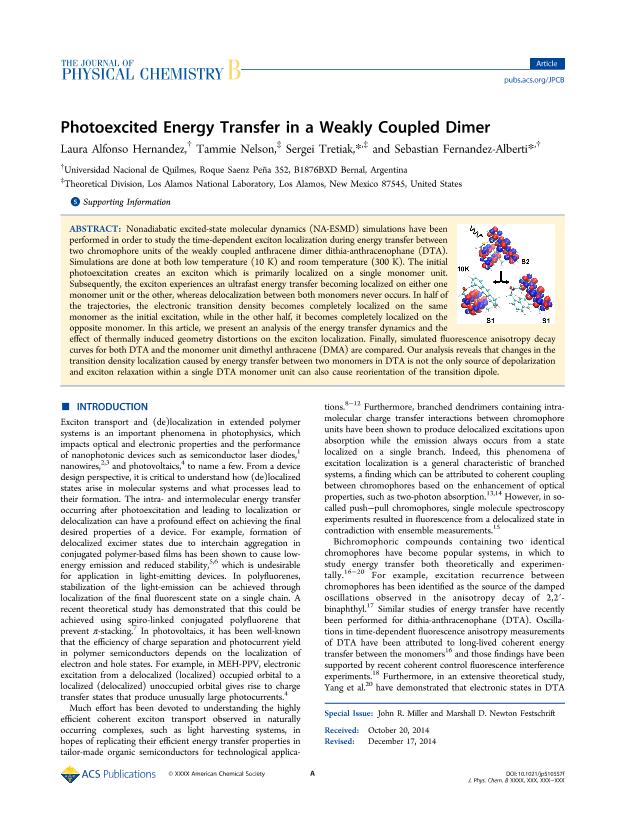Mostrar el registro sencillo del ítem
dc.contributor.author
Alfonso Hernandez, Laura

dc.contributor.author
Nelson, Tammie
dc.contributor.author
Tretiak, Sergei
dc.contributor.author
Fernández Alberti, Sebastián

dc.date.available
2018-02-26T19:03:17Z
dc.date.issued
2015-06
dc.identifier.citation
Alfonso Hernandez, Laura; Nelson, Tammie; Tretiak, Sergei; Fernández Alberti, Sebastián; Photoexcited energy transfer in a weakly coupled dimer; American Chemical Society; Journal of Physical Chemistry B; 119; 24; 6-2015; 7242-7252
dc.identifier.issn
1520-6106
dc.identifier.uri
http://hdl.handle.net/11336/37134
dc.description.abstract
Nonadiabatic excited-state molecular dynamics (NA-ESMD) simulations have been performed in order to study the time-dependent exciton localization during energy transfer between two chromophore units of the weakly coupled anthracene dimer dithia-anthracenophane (DTA). Simulations are done at both low temperature (10 K) and room temperature (300 K). The initial photoexcitation creates an exciton which is primarily localized on a single monomer unit. Subsequently, the exciton experiences an ultrafast energy transfer becoming localized on either one monomer unit or the other, whereas delocalization between both monomers never occurs. In half of the trajectories, the electronic transition density becomes completely localized on the same monomer as the initial excitation, while in the other half, it becomes completely localized on the opposite monomer. In this article, we present an analysis of the energy transfer dynamics and the effect of thermally induced geometry distortions on the exciton localization. Finally, simulated fluorescence anisotropy decay curves for both DTA and the monomer unit dimethyl anthracene (DMA) are compared. Our analysis reveals that changes in the transition density localization caused by energy transfer between two monomers in DTA is not the only source of depolarization and exciton relaxation within a single DTA monomer unit can also cause reorientation of the transition dipole.
dc.format
application/pdf
dc.language.iso
eng
dc.publisher
American Chemical Society

dc.rights
info:eu-repo/semantics/openAccess
dc.rights.uri
https://creativecommons.org/licenses/by-nc-sa/2.5/ar/
dc.subject
Non-Adiabatic Molecular Dynamics
dc.subject
Conjugated Molecules
dc.subject
Excited States
dc.subject.classification
Otras Ciencias Químicas

dc.subject.classification
Ciencias Químicas

dc.subject.classification
CIENCIAS NATURALES Y EXACTAS

dc.title
Photoexcited energy transfer in a weakly coupled dimer
dc.type
info:eu-repo/semantics/article
dc.type
info:ar-repo/semantics/artículo
dc.type
info:eu-repo/semantics/publishedVersion
dc.date.updated
2018-02-26T15:09:36Z
dc.journal.volume
119
dc.journal.number
24
dc.journal.pagination
7242-7252
dc.journal.pais
Estados Unidos

dc.description.fil
Fil: Alfonso Hernandez, Laura. Universidad Nacional de Quilmes. Departamento de Ciencia y Tecnología; Argentina. Consejo Nacional de Investigaciones Científicas y Técnicas; Argentina
dc.description.fil
Fil: Nelson, Tammie. Los Alamos National Laboratory; Estados Unidos
dc.description.fil
Fil: Tretiak, Sergei. Los Alamos National Laboratory; Estados Unidos
dc.description.fil
Fil: Fernández Alberti, Sebastián. Universidad Nacional de Quilmes. Departamento de Ciencia y Tecnología; Argentina. Consejo Nacional de Investigaciones Científicas y Técnicas; Argentina
dc.journal.title
Journal of Physical Chemistry B

dc.relation.alternativeid
info:eu-repo/semantics/altIdentifier/doi/http://dx.doi.org/10.1021/jp510557f
dc.relation.alternativeid
info:eu-repo/semantics/altIdentifier/url/https://pubs.acs.org/doi/10.1021/jp510557f
Archivos asociados
